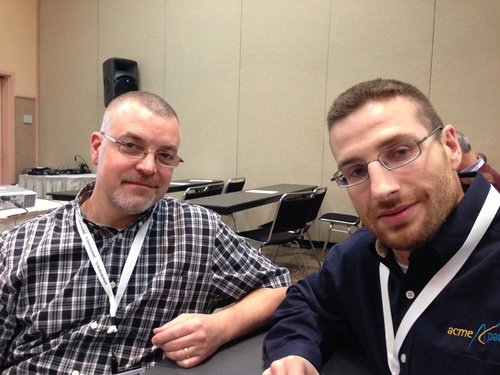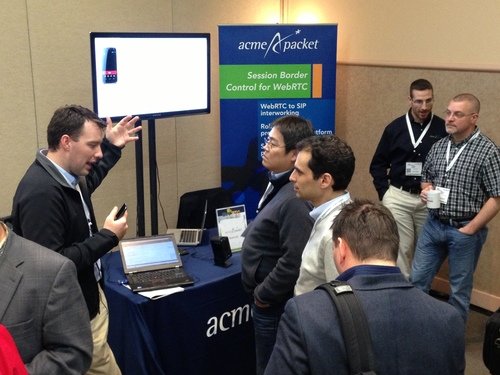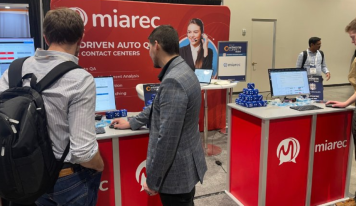At the inaugural WebRTC Conference & Expo in San Francisco, much of the crowd was focused on demos of WebRTC working in a production environment. In one example at a luncheon keynote Mozilla showed how WebRTC communications could take place between two browsers on the same laptop. This one of the first demonstrations of the technology much of the audience had ever seen.
The event has brought together a wide swath of technology companies like Google, Plantronics, Oracle, Sangoma and Ericsson who are all very optimistic about the potential for WebRTC to be as some describe it, “A once in a lifetime opportunity in telecom.”
One speaker at a standards panel today mentioned perhaps the biggest challenge to WebRTC is overhyping. And he is partially correct. A bigger challenge to this emerging new space may be security.
Patrick McNeil and Chad Hart of Acme Packet
This is where a player like session border control maker Acme Packet comes in. I spoke at length with Chad Hart, Director of Product Marketing and Patrick McNeil, Senior Security Engineer, CISP from the company earlier today at the show and the takeaway is they are getting ready for the second wave of WebRTC… When it gets deployed in the real-world, across network borders.
The point is that past technologies like VoIP and SIP had to deal with major regulatory issues once the technologies reached critical mass. The FCC for example put onerous 911 regulations on the VoIP market as a result of a death related to a VoIP line which didn’t support E911.
Hart says you need to get ahead of these situations as we leave phase one of adoption and head to phase 2.
Moreover, he pointed out that call centers will be some of the earliest adopters of WebRTC and will benefit from the technology a great deal and as a result they need to be ready to deal with recording and compliance issues which will have to now apply to WebRTC customer interactions.
This is where an SBC company shines and explains why the company was here and moreover, why there was so much interest in their booth.
As you might imagine, the company is evangelizing WebRTC as they stand to benefit greatly if the technology fulfills its role as a major enabler of the communications of the future. A simple way to think of WebRTC is basically open Skype which lives in the browser and doesn’t require a plugin. In other words, WebRTC could easily eliminate the need for Skype over time. I am not saying it will – after all, Skype provides many useful services such as acting an address book but you get the idea.
Acme showed an interesting demo called a “happy button” which allows a user on a website to click an icon to immediately connect with an agent while in context. Coincidentally, I recently was in the market for an SUV and none of the automobile websites allowed me to calculate my precise lease payments online. In each case I had to wait for the dealer to reach out to me. It seems they wanted me to speak with someone directly before I got a quote. As it turns out, I made a purchase before half of the dealers responded.
The “happy button” in contrast allows a user to click a button on a website during a transaction in order to be connected with an agent who is aware of the issue at hand based upon user’s browsing information. The alternative says Hart is to leave the screen, do a search for the company’s contact information, traverse an IVR tree, find an agent and potentially have to re-authenticate a second time.
All of this adds cost to the company providing the call center service when you consider the cost of the IVR, programming the IVR, the 800 number minutes and the time the agent needs to authenticate users.
Moreover, in my case at least – half the companies contacted, lost the opportunity for me to purchase from them because of spam filters or they called me back while I was busy. Keeping a buyer waiting to get a price is never a smart thing to do.
At this event Acme Packet also announced the first WebRTC to multivendor IMS interworking capability where they enabled a major tier one network operator to deploy what amounts to a WebRTC to IMS SIP gateway.
On a separate but related note, the company also discussed the release of their 6300 SBC which can scale to 200k sessions and 1M subscribers in a 3U chassis. They explain that as VoLTE rolls out and VoIP providers mature, the demand for higher capacity systems has grown. Moreover, this new platform can be 70% cheaper than purchasing multiple 4500s and supports simultaneous transcoding of 64k sessions and 32k sessions of simultaneous encryption.
McNeil will speak tomorrow on security in the world of WebRTC and it seems fairly obvious that corporations and carriers will need to be paying close attention to what he and others in the SBC space have to say about security. These companies have learned a great deal in the VoIP and SIP space and as WebRTC gets ready for its second wave, it will have to deal with some of these same issues as well.






